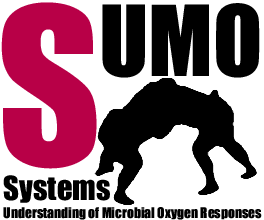Changes between Version 29 and Version 30 of public
- Timestamp:
- Apr 29, 2011, 10:05:34 AM (14 years ago)
Legend:
- Unmodified
- Added
- Removed
- Modified
-
public
v29 v30 20 20 ==== SysMO - SUMO,,1,, - Systems Understanding of Microbial Oxygen Responses ==== 21 21 22 This project first started out in 2007 named SUMO (Systems understanding of Microbial oxygen responses) and was founded by the European research initiative !SysMo([http://www.sysmo.net SysMo]). During the first 3years of founding we used a multiple systems level approach to broaden our knowledge about the metabolic adaption that occurs in response to changes in oxygen availability. Especially the application of commonly agreed protocols which led to highly reproducible transcriptomic, proteomic, metabolomic and biochemical data sets helped to describe the dynamics of ''E.colis'' response to oxygen. Specifically, we investigated how this bacterium senses oxygen or the associated changes in oxidation/reduction balance, via the Fnr and ArcA proteins, how these systems interact with other regulatory systems, and how the redox response of an ''E. coli'' population is generated from the responses of single cells. Furthermore these data sets of high quality have been implemented into mathematical models and computer science models of various types (e.g. ODE- and Agent-based modeling). This allowed us to set up new model-based hypothesis and additionally on this basis new experiments have been designed to help validate our models and extend our knowledge about metabolism.22 This project first started out in 2007 named SUMO (Systems understanding of Microbial oxygen responses) and was founded by the European research initiative SysMO ([http://www.sysmo.net SysMo]). During the first 3years of founding we used a multiple systems level approach to broaden our knowledge about the metabolic adaption that occurs in response to changes in oxygen availability. Especially the application of commonly agreed protocols which led to highly reproducible transcriptomic, proteomic, metabolomic and biochemical data sets helped to describe the dynamics of ''E.colis'' response to oxygen. Specifically, we investigated how this bacterium senses oxygen or the associated changes in oxidation/reduction balance, via the Fnr and ArcA proteins, how these systems interact with other regulatory systems, and how the redox response of an ''E. coli'' population is generated from the responses of single cells. Furthermore these data sets of high quality have been implemented into mathematical models and computer science models of various types (e.g. ODE- and Agent-based modeling). This allowed us to set up new model-based hypothesis and additionally on this basis new experiments have been designed to help validate our models and extend our knowledge about metabolism. 23 23 24 24 ==== SysMO - SUMO,,2,, - Systems Understanding of Microbial Oxygen-Dependent and Independent Catabolism ==== 25 25 26 In 2011 we kindly received another funding from the !SysMo-initiative. Here in SUMO,,2,, our aim is to extend our SUMO,,1,, project work to obtain a complete, quantitative description of the integrated catabolic subsystems of ''E. coli'', from regulation to energy conservation. To achieve this goal, SUMO,,2,, will build upon the progress made in SUMO by extending our systematic analysis of ''E. coli'' catabolism into three new thematic areas:26 In 2011 we kindly received another funding from the SysMO-initiative. Here in SUMO,,2,, our aim is to extend our SUMO,,1,, project work to obtain a complete, quantitative description of the integrated catabolic subsystems of ''E. coli'', from regulation to energy conservation. To achieve this goal, SUMO,,2,, will build upon the progress made in SUMO by extending our systematic analysis of ''E. coli'' catabolism into three new thematic areas: 27 27 28 28 1. System dynamics during transition to anaerobic respiration and in response to pulses of electron acceptors
